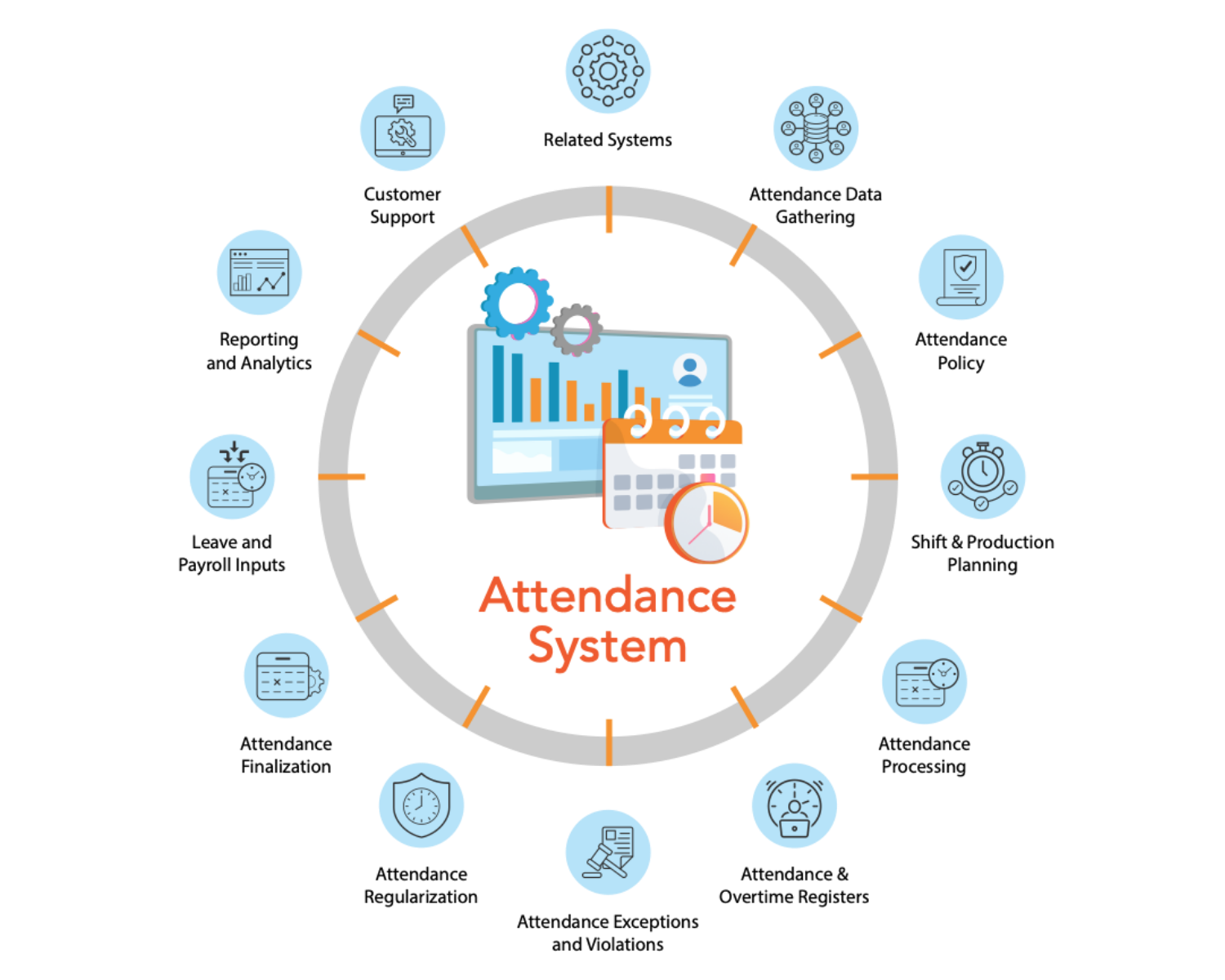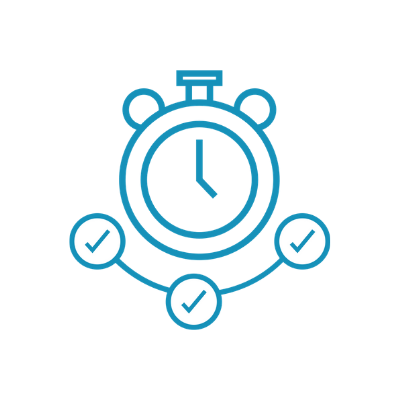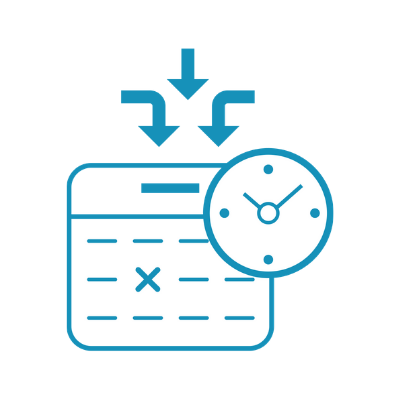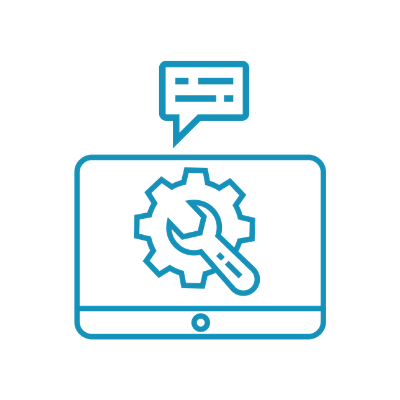Managing the attendance of employees is one of the significant responsibilities in HR operations. Like any other domain, understanding the scope of the operations, the various concepts, and best practices are essential for effective management. This guide provides a comprehensive overview of all aspects of the attendance system and the key responsibilities of an administrator handling attendance and workforce management.
In the interest of keeping this article brief, we have moved some in-depth content to a related article with just the overview here. Be sure also to check out the additional links spread all over the article for more information.
Table of Contents
- 1. What is Attendance?
- 2. Need for Attendance Management
- 3. The Attendance System
- 4. What is Attendance Management?
What is Attendance?
Attendance is the action or state of being present at a place of work according to the company's policies. The opposite of attendance is absence from work.
But it is not as simple as that. In most companies, an employee has to be present within a specific period for a certain number of hours to be considered as being present.
For example, if an employee comes to a factory at 3:00 PM and leaves after just one hour of work, it does not count. The employee needs to be present from the start till the end of the shift.
However, for teams that are not customer-facing or work is not time-dependent, attendance could mean putting in 8 hours of work per day. It could be 9 to 5 one day and 6 to 2 on another day.
Apart from the narrow definition above, attendance can be considered a short-hand term to cover a wide range of concerns like absenteeism, time discipline, time accounting, workforce management, productivity, etc.
Need for Attendance Management
Tracking an employee's attendance is essential to your company's profitability, reliability, and reputation. There are seven broad reasons why attendance management is required:

Productivity
Time spent doing work is a crucial input variable of production involving human workers. So, more time at work means higher productivity.
Smooth Running Of Operations
It's not just the personal productivity of one employee at stake but the productivity of the team and the overall organization. The absence of a team member leads to coordination issues, delays, higher work-in-progress (WIP), or inventory. But when this happens multiple times with different people, the impact of absence multiples instead of just adding up.
Discipline
A lack of discipline in the organization leads to unpredictability, delays, and variability of both quality and the delivery schedule. Indiscipline is also infectious. It influences other employees also to adopt the bad habit and thus compound the issue.
When conscientious employees notice that indiscipline is tolerated and ignored, at first, they are frustrated and resentful. Eventually, they may leave the organization searching for a better workplace while the employer brand suffers a big blow.
From a lean management angle, time discipline helps in reducing variability and delays.
Overtime
Many organizations like hospitals, retail, and factories operate multiple shifts. Even so, high production demand may require people to work overtime beyond regular working hours or on weekends or holidays.
A proper time tracking system and accounting practice are essential both from a cost-efficiency perspective and higher employee satisfaction. A lack of a sound system will lead to disputes, higher employee expense, and lots of stress for the administrators.
Time Theft
The original reason time clocks were introduced in the industrial era was to ensure people got paid only when they were at work. Without accurate timekeeping, some people may misuse the system and indulge in time theft through late arrival, early out, too many coffee breaks, etc.
The only solution to time theft is to have a fool-proof system for tracking attendance and enforcing policy consistently and diligently.
With an overtime policy, some employees tend to push work that could have been done in regular time to overtime hours. This is just another type of time theft. Once again, good record-keeping and tracking can go a long way in curbing misbehavior.
Accurate Payroll Inputs
Attendance inputs are crucial to accurately calculate the salaries of employees. Salaries are paid for the days worked and this information is ascertained from attendance data. In addition to this, attendance data is also used to calculate Shift Allowances, Attendance Bonus and Overtime payments.
Compliance
Attendance data is needed for various compliance reports also. These reports are in the areas of hours worked for a day and week, Shifts worked on, Overtime hours worked and information on days present and days when an employee is on Leave or is absent.
In India, these reports are to be generated under various Acts like the Factories Act, Shops & Establishment Acts, etc.
What Types of Industries Need Attendance Management?
Most industries in the manufacturing sector and the service sector work during fixed business hours. Factories, assembly plants, retail shops, schools, hospitals, software companies, financial institutions, etc., all need to have a sound attendance management system.
Organizations that operate on multiple shifts need to ensure employees are present during shift timings for seamless work processing.
Many industries require extended hours of work from their employees either during the workday or during weekends. To comply with the laws and to accurately pay overtime, time tracking is essential.

Do I Need to Care About Attendance Management?
Wouldn't it be great if we didn't have to manage time and attendance at all? Since tracking attendance is a daily effort and multiplies with headcount, it's worth asking this question.
ROWE
Some organizations are innovating with a concept called Result Only Work Environments (ROWE) aimed at smashing the clock. In such an organization, employees are free to come and go as per their convenience and are accountable for the results alone.
A ROWE organization does not require time tracking since no attendance policy is enforced, and employees set their own rules.
Knowledge Industries
Many industry verticals like information technology, pharmaceuticals, healthcare, education, science, finance, consulting are considered knowledge industries. The quality of time, energy, and cognitive state play a significant role in productivity than just the number of hours a knowledge worker spends at work.
However, any organization that serves customers directly is bound to operate during business hours. For responsive service and low lead times, all teams need to be working in tandem, including the knowledge workers.
Another counterintuitive aspect is overwork since knowledge work will draw as many hours as you can provide without any end to work. In such situations, timekeeping may instill discipline leading to higher productivity and less burnout.
The Attendance System
Managing the attendance of employees is a complex activity. There are multiple aspects or parts of the overall attendance system. Like in any system, all of these parts are interconnected and necessary for the system to work well.

Attendance Data Gathering

The log of an employee coming or going from work is called a time punch or a swipe. At a minimum, a log entry must contain the employee's ID and a timestamp. The door info and movement type (in/out) can also be relevant for establishments with multiple entry points.
One of the oldest ways of tracking attendance data is to maintain a paper-based attendance register and let employees mark their attendance every day. Nowadays, there are multiple ways of capturing attendance ranging from biometric hardware devices to mobile-based attendance recording.
Accurate capturing of daily swipe data of employees is vital since every other aspect will depend on this data. Being a daily activity, the volume of this data is directly proportional to the number of employees and the frequency of employee movements in and out of the premises.
Automated methods of capturing and processing attendance data help reduce administrative effort and costs.
Attendance Policy

The attendance policy of an organization defines the shifts, working hours, and disciplinary rules. An attendance policy consists of the following sections:
- Shift definition and shift rotation policy
- Regularization policy
- Overtime policy including eligibility and payout rates
- Penalties for violating the rules
- Work-day calendar including off days and holidays
The attendance policy is required to process the raw attendance swipes of employees and compute the actual hours worked, overtime, late coming, etc.
Shift & Production Planning

In some organizations, production planning and shift rostering are regular activities either done by HR administrators or team managers.
A shift roster lists the employees for a given shift for a period (week or month). This roster is then communicated to employees. In multiple shifts, shift rotation ensures that employees move between various shifts like the morning and night shifts.
Attendance Processing

Attendance processing is just like making tomato soup.
Are three ripe, red tomatoes the same as a bowl of hot tomato soup? Of course, not.
We need to wash, puree, boil, and simmer those red tomatoes to get tasty soup. We also need to add salt, pepper, and a dash of cream.
Similarly, having the raw attendance swipes for a day is not enough. During attendance processing, we need to pull other information and do some computations to get our results. We need:
- the attendance policy (see above) in all its dimensions
- the shift roster
- holiday calendar
- the leave status of the employee for the day
- any special permissions or exceptions for the employee
An Example
Let's consider employee X, who has the following attendance swipes for Tuesday on 12th Jan 2021.
X, 2021-01-12T9:12:10+05:30, IN, Door1
X, 2021-01-12T5:22:10+05:30, OUT, Door2
We need the shift information to determine the attendance status and the actual hours worked. Let's say it's a General Shift from 9:00 AM to 5:00 PM.
We can now compute the total hours worked for the employee as 8 hours and 10 minutes.
This is where the attendance policy comes into the picture. If the policy says only work done during the shift hours is counted, the actual hours worked will be 7 hours and 48 minutes.
We notice that the employee is late to work by 12 minutes. Suppose the employee had worked till 8:00 PM, and the organization has an overtime policy. In that case, we could compute the excess hours worked as 3 hours. This extra time qualifies for overtime depending on the overtime policy and rate.
As the above example demonstrates, attendance processing involves the following steps:
- computing the actual hours worked, total hours at work, overtime hours, late-in minutes, early-out minutes, etc.
- identifying violations as per company policy
- computing overtime
- intimating employees about the violations to avoid false positives
Daily Vs. Monthly Processing
Many organizations without automated systems prefer to process attendance once a month. Some organizations do it on a weekly or daily basis. The advantage of daily attendance processing over monthly processing is that the feedback to employees is immediate and leads to better policy enforcement.
However, it's not possible to determine the actual attendance status of an employee within a day or two. For example, consider an employee who has not come to work on Monday. You cannot view this as "unauthorized absence" because, two days later, the employee might apply for sick leave for Monday.
The solution is to keep processing attendance for the entire month daily since a violation last Monday may get regularized a week later.
Due to this enormous burden and waste of effort, organizations without automated systems prefer to process attendance monthly instead of doing it daily. In the bargain, you lose out on effective policy enforcement. Computerized systems can solve this problem by eliminating the effort while ensuring real-time attendance processing daily.
Attendance & Overtime Registers

After processing attendance, we get a detailed attendance record for an employee for a day or the entire month. A muster roll is an attendance register of all employees for all days in a month.
An overtime register consists of total overtime done by an employee for the month. This information flows to the payroll administrator for overtime payments.
Attendance Exceptions and Violations

After processing attendance, we need to check if employees comply with the attendance policy or not. In case of any policy violations, we may warn the employees during a grace period. Beyond that, we need to impose penalties for the violations.
There could be several violations that can be flagged. For example:
- Habitual late coming (with a grace of 2 times per month allowed)
- Habitual early out
- Continuous absence for three days or more
- A shortfall in actual hours worked per week (for example, against the required 40 hours)
The administrator must share the feedback with the employees and their managers at the earliest. Because, at times, there could be genuine reasons for the deviation, including device malfunction or lateness due to official external work.
With early feedback, an employee can recall the situation and provide reasons for the violations. On the other hand, it is tough to remember the cause of a violation after a month. Such delays usually end in disputes and high employee dissatisfaction with the attendance process.
Attendance Regularization

An employee could be present on a working day but still be flagged as being absent, late for work, or without a punch-in or a punch-out for the day. Such false positives occur for several good reasons, including hardware failures, external office duty, emergencies for which permission was obtained, etc.
Imagine the annoyance level of an employee who puts in a hard day's work but is considered absent or a late-comer. It seems like being accused of time theft and being less committed and engaged at work.
The solution is to gently inform the employee that there is an anomaly in the records and request them to regularize the attendance issue by the end of the monthly cut-off date. The employee gets a chance to rectify the problem without any adverse remarks or consequences.
The earlier the feedback, the easier it's for an employee to fix the issue. It's difficult to remember and justify why someone was late to work a month back. Employees generally feel there must have been some good reason for it, but since they can't explain it, they will feel victimized by the stupid system. On the other hand, some employees might be absent but claim forgetfulness as an excuse for their lapses.
For all these reasons, daily attendance processing is a good practice. We can notify employees about such issues immediately and enforce the policy with rigour. It promotes accountability without creating dissatisfaction or damaging the employer brand.
Attendance Finalization

The existence of false positives requires attendance regularization. But, until the incident is regularized, the final attendance status is undecided. Like Schrodinger's cat, the employee is in a dual state of being both present and absent at the same time.
By the time the attendance period cut-off approaches and we have to prepare payroll advice for the month, we need to take a final call on these cases.
All exceptional cases are reviewed as per the attendance policy and the various penalties applied to each case. As always, the management has the discretion to overrule and pardon certain instances.
After the attendance finalization, we have a list of violations for various employees and the corresponding penalties.
There are many types of policy violations like unauthorized absence for the entire day, habitual lateness, time-theft, etc. The types of penalties can vary for each of these violations.
For unauthorized absence, we deny the wages for that day with a loss-of-pay (LOP) entry. Sometimes, instead of deducting wages, we deduct a day from the leave balances.
As for other policy violations, it's at the discretion of the company and its view on enforcing discipline in the workforce. For example, suppose an employee is continuously late for three days in a row. In that case, we could penalize the employee in many ways:
- deduct half a day leave from the leave balance
- deduct half a day wages from the salary
- impose a fine of Rs 500 (irrespective of the wages earned)
Attendance finalization is where the rubber meets the road. When policies are not enforced, and there are no consequences for violating the policy, it breeds indiscipline and disrespect for the companies policies. Even worse, inconsistent enforcement generates feelings of bias, injustice, and discontent.
Leave and Payroll Inputs

The output of the finalization process is a statement of various leave and LOP adjustments for all employees for the attendance period.
The leave inputs should lead to the leave balances getting adjusted for the employee after leave deductions.
The payroll inputs should reduce the total working days for the month and reduce the salary. Also, any fines should be applied as deductions to the gross salary.
Reporting and Analytics

Various state and central government rules require the maintenance of muster rolls along with leave and wage data. So, for each month, an attendance register in prescribed format needs to be maintained for all the employees.
Apart from compliance reporting, the organization must review the overall attendance report for a month and glean insights. Absenteeism at an individual level is a vital signal from an employee that should be investigated and addressed. Absenteeism at an overall level is much more alarming. It could be detrimental to the overall organizational health if remedial action is not taken.
Apart from being done at a monthly and org-wide level, the attendance analysis should be done for more extended periods and can drill down to departmental, team, or individual. You should also correlate the data with environmental factors like the holiday season, year-end, etc.
Customer Support

Like any other HR operations activity, employees need much support from HR related to attendance management. Queries about attendance policy, clarifications, and specific issues around attendance regularization or incorrect processing are natural.
The employees will also need detailed muster roll and attendance computation for the whole month. If there is overtime, the overtime computation will also need to be shared with employees.
Employee complaints related to attendance devices, access cards, or biometric recognition issues can also crop up from time to time.
Delays in fixing issues lead to unnecessary employee costs, inaccurate attendance data, poor policy enforcement, and employee dissatisfaction.
A web-based or cloud Employee Portal can help reduce the load on administrators by providing self-service options to employees. It leads to lower workloads, faster resolution, transparency, and higher employee satisfaction.
Related Systems

For smooth and simplified operations, the attendance system needs seamless integration with various systems like:
- Employee information system (HRIS)
- Workforce management (scheduling)
- Overtime management
- Leave management
- Payroll management
What is Attendance Management?
Attendance management is a set of activities and employee processes essential for time accounting, discipline, productivity, and statutory compliance.
As we saw in the previous section, the attendance system consists of many parts. All of these sub-systems need to function well for the whole system to work well. An administrator's job is to set up and run each sub-system efficiently, day after day.
Attendance management involves:
designing attendance policies
Shift management and shift rostering
managing and operating attendance devices & registers
maintaining accurate time records
processing raw attendance data
managing and paying overtime
employee communications and alerts: sharing live attendance info every day as feedback to employees, informing about the shift roster, announcements, and so on.
monitoring attendance processes like attendance regularization and overtime approvals
finalization of attendance and overtime within cut-off dates
enforcing attendance policies by acting on violations
statutory compliance
preparing MIS reports and deriving insights
monitoring absenteeism individually and collectively
running an employee help desk for employee queries and support


